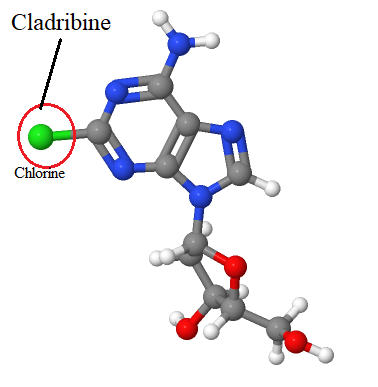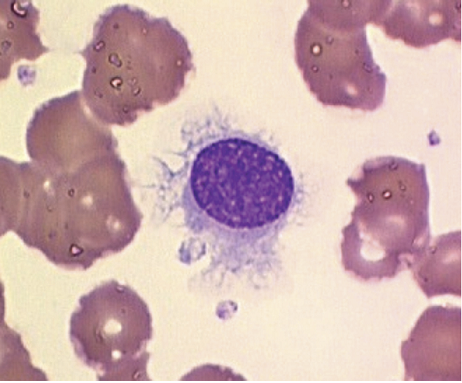|
|
|
Medical Pharmacology Chapter 33-34: Anticancer Drugs
Antimetabolites
Purine Analogues:
Cladribine (Leustatin, Mavenclad and others)
|
|
 |
|
|
||||
References
|
||||
![]() Cladribine
(2-Chlorodeoxyadenosine, Leustatin), an
adenosine deaminase (ADA)-resistant. purine analog, with
activity against low-grade lymphoproliferative cancer, particularly hairy
cell leukemia10 (leukemic reticuloendotheliosis; the, designation
i.e. hairy cell leukemia was based on the "hairy" appearance of malignant B
cells).
Cladribine
(2-Chlorodeoxyadenosine, Leustatin), an
adenosine deaminase (ADA)-resistant. purine analog, with
activity against low-grade lymphoproliferative cancer, particularly hairy
cell leukemia10 (leukemic reticuloendotheliosis; the, designation
i.e. hairy cell leukemia was based on the "hairy" appearance of malignant B
cells).
|
|
|
|
 |
|
![]() Other
low-grade lymphoproliferative diseases that may benefit from cladribine
treatment include CLL (chronic lymphocytic leukemia) and low-grade
non-Hodgkin's lymphoma.
Other
low-grade lymphoproliferative diseases that may benefit from cladribine
treatment include CLL (chronic lymphocytic leukemia) and low-grade
non-Hodgkin's lymphoma.
Cladribine is also effective in treating multiple sclerosis and childhood leukemia.
Cladribine is considered a prodrug, requiring activation following its transport into cells by active nucleoside transport.1,3
Activation requires phosphorylation steps catalyzed first by deoxycytidine kinase, forming the monophosphate and ultimately the triphosphate form, which can be incorporated into DNA.1,3
The triphosphate active metabolite inhibits DNA synthesis and DNA repair by means of inhibiting DNA polymerase-α and DNA polymerase-β, respectively.
Cladribine triphosphate incorporation into DNA promotes strand breakage as well as NAD and ATP depletion, a trigger for programmed cell death (apoptosis)
![]() By contrast to many anti-neoplastic agents, cladribine triphosphate does not
require active cell division to exhibited cytotoxicity.
By contrast to many anti-neoplastic agents, cladribine triphosphate does not
require active cell division to exhibited cytotoxicity.
Cellular resistance to the action of cladribine triphosphate is likely due to: 1,3
Decreased levels or loss of deoxycytidine kinase (dCK), the enzyme that activates the prodrug parent agent,
Cladribine increased amounts of ribonucleotide reductase or
Increased active drug efflux, out of the cell, by means of the ABC transporter family member, primarily ABCG2.1,3
![]() Activation
of cladribine is dependent on sequential intracellular phosphorylation,
reactions catalyzed by deoxycytidine kinase (dCK).8
Activation
of cladribine is dependent on sequential intracellular phosphorylation,
reactions catalyzed by deoxycytidine kinase (dCK).8
The triphosphate metabolite (5'-triphosphate metabolite) is 2-chloro-2'-deoxyadenosine 5-triphosphate (2-CdATP) builds up in cells expressing deoxycytidine kinase at high levels.
2-CdAMP (the monophosphate form) following DNA incorporation causes DNA strand breaks.8
Furthermore, three sequential Cl-d-AMP (2-Chloro-2'deoxyadenosine monophosphate) residues and DNA prevents strand elongation. 8,12
Cladribine monophosphate can directly inhibit transcription if it is incorporated into DNA promoter sequences.8,13
In an in vitro test system binding interactions of the human TATA box-binding protein were disruptive in 2-chlorodeoxyadenosine monophosphate (CldAMP)-substituted TAT box consensus sequences.
In such cases in vitro polymerase II transcription was reduced by about one-third compared to control substrates.
["A TATA box is a DNA sequence that indicates where genetic sequence can be read and decoded. It is a type of promoter sequence, which specifies two other molecules were transcription begins. Transcription is a process that produces an RNA molecule from a DNA sequence".] 14
|
|
|
Cl- dATP (the 5'-triphosphate fludarabine metabolite) also is an effective inhibitor of ribonucleotide reductase (RNR), resulting in an imbalance of deoxyribonucleotide triphosphate pools.8
A consequence of such imbalance is impairment of DNA synthesis and repair.
Cladribine triphosphate may induce apoptosis in certain cells.
In these cases the triphosphate analog of cladribine interacts with protease activating factor-1 (PAF-1) and cytochrome C, thus initiating caspase cascade resulting in DNA degradation.8
Absorption, Distribution, Biotransformation, Excretion:1
Cladribine exhibits an oral bioavailability of about 50%. 1
The agent is not FDA approved for oral administration. It is under consideration by the FDA in the oral formulation as a treatment for multiple sclerosis.
Cladribine is administered intravenously and is excreted by the kidneys.
The terminal t1/2 is about 7 hours.
![]() Because of
the importance of renal excretion, cladribine dosages are typically adjusted
in accord with the presence and extent of renal dysfunction.
Because of
the importance of renal excretion, cladribine dosages are typically adjusted
in accord with the presence and extent of renal dysfunction.
Cladribine clearance is about 40 liters/h/m2 (children).16
Cladribine is able to cross the blood-brain barrier allowing CSF concentrations to reach about 25% of plasma levels.1
![]() Toxicity:1
Toxicity:1
Myelosuppression following cladribine administration is the principal dose-limiting toxic response.
Repeated courses of treatments containing cladribine may be associated with thrombocytopenia.
Reduced CD4+ T-cell levels following cladribine therapy predispose patients to opportunistic infections.
A range of other toxic reactions include nausea, fever, infections, fatigue, and tumor lysis syndrome.1